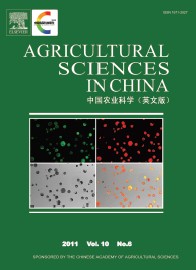|
|
Isolation and Expression Patterns of Rice WRKY82 Transcription Factor Gene Responsive to Both Biotic and Abiotic Stresses
PENG Xi-xu, TANG Xin-ke, ZHOU Ping-lan, HU Yao-jun, DENG Xiao-bo, HE Yan and WANG Hai-hua
2011, 10(6):
893-901.
DOI: 10.1016/S1671-2927(11)60074-6
WRKY transcription factors are involved in the regulation of response to biotic and abiotic stresses in plants. A fulllength cDNA clone of rice WRKY82 gene (OsWRKY82) was isolated from a cDNA library generated from leaves infected by Magnaporthe grisea. OsWRKY82 contained an entire open reading frame in length of 1 701 bp, and was predicted to encode a polypeptide of 566 amino acid residues consisting of two WRKY domains, each with a zinc finger motif of C2H2,belonging to the WRKY subgroup I. OsWRKY82 shared high identity at the amino acid level with those from Sorghum bicolor, Hordeum vulgare, and Zea mays. The transcript level of OsWRKY82 was relatively higher in stems, leaves, and flowers, and less abundant in grains. It was induced by inoculation with M. grisea and Rhizoctonia solani. However, the inducible expression in incompatible rice-M. grisea interactions was earlier and greater than that in compatible interactions.The expression of OsWRKY82 was up-regulated by methyl jasmonate and ethephon, whereas salicylic acid exerted no effects on its expression. Moreover, OsWRKY82 exhibited transcriptional activation ability in yeast. Additionally,OsWRKY82 transcripts could be induced by wounding and heat shocking, but not by abscisic acid, cold, high salinity and dehydration. By contrast, gibberellin suppressed the expression of OsWRKY82. These indicate that OsWRKY82 is a multiply stress-inducible gene responding to both biotic and abiotic stresses, and may be involved in the regulation of defense response to pathogens and tolerance against abiotic stresses by jasmonic acid/ethylene-dependent signaling pathway.
|
